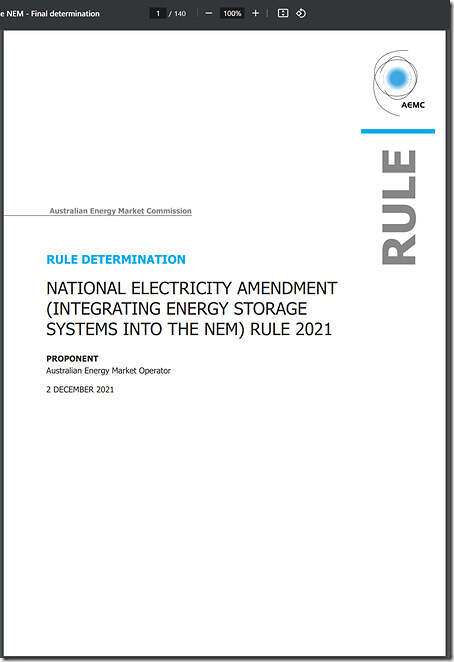Earlier today the AEMC published their final determination on a rule change relating to the integration of storage systems into the NEM.:
| The Report | Other Materials |
|---|---|
|
You can download the 140-page PDF of the Rule Determination here: |
Further information about the rule determination, and the process that led to this, is catalogued on the AEMC website under Project ERC0280.
|
The project site refers to the Media Release ‘Next step in making the power grid ‘storage friendly’ is underway’ from 20th August 2020 at the commencement of the process, plus much more.
The initial rule change request was submitted by the AEMO on 23rd August 2019 and sought to address issues with how the market operator identified and registered utility-scale batteries, aggregations of smaller batteries, and hybrid facilities.
The final determination
The final rule contained some key changes relating to the registration of storage and hybrid facilities:
- An introduction of a new participant category — “Integrated Resource Provider (IRP)”, designated for storage and hybrid facilities.
- Storage will be treated as a single unit for the purpose of dispatch, increasing the number of bid bands to 20 (x10 for load and x10 for generation).
- Hybrid DC-coupled systems are allowed to register as scheduled, semi-scheduled, or both.
- Aggregators of small units and existing small generation aggregators will be moved to the IRP category, allowing them to participate in the ancillary services market.
Somewhat more controversially for some, the rule change also clarified how storage systems will be treated in relation to non-energy costs and network charges:
- Non-energy cost recovery would be based on a participant’s gross energy flows.
- Use of two new data streams in non-energy cost recovery — Adjusted Sent Out Energy (ASOE) and Adjusted Consumed Energy (ACE).
- A proposal to exempt pumped hydro and batteries from paying network charges was not accepted. This means that storage will continue to connect under a:
- negotiated agreement at the transmission level
- direct control service tariff or a storage tariff trial option, where offered, at the distribution level.
Initial reaction about the rule change
Much of the initial commentary on the rule change has focused on the network charges aspect of the announcement.
Clean Energy Council
The Clean Energy Council came out this morning with a media release arguing that the rule change places batteries and pumped hydro at a disadvantage to coal and gas.
Here they stated that the determination “will result in consumers paying twice for network charges – first through higher electricity prices and again through standard network charges.”
RenewEconomy
On Tuesday, Giles Parkinson of RenewEconomy posted about the then-upcoming announcement in his article New network fees could “kill the viability” of battery and pumped hydro storage.
He wrote “Battery operators say it is still difficult to make significant returns from arbitrage, or time-shifting wind and solar output from periods of low demand and low prices, to periods of high demand and higher prices”, adding “the technology needs market volatility, but its returns will be eaten away with the imposition of new network fees.”



Leave a comment